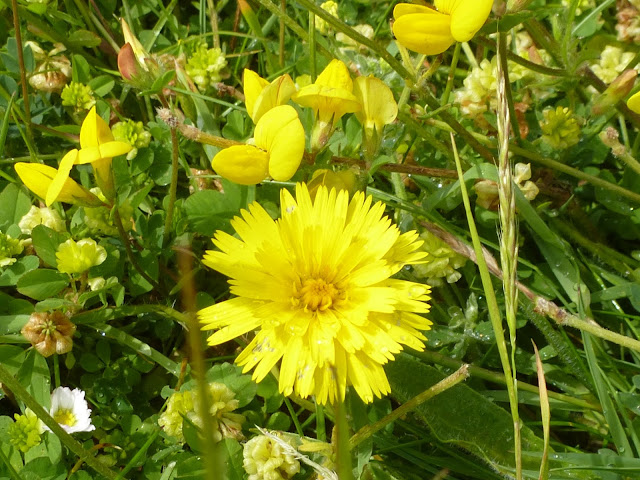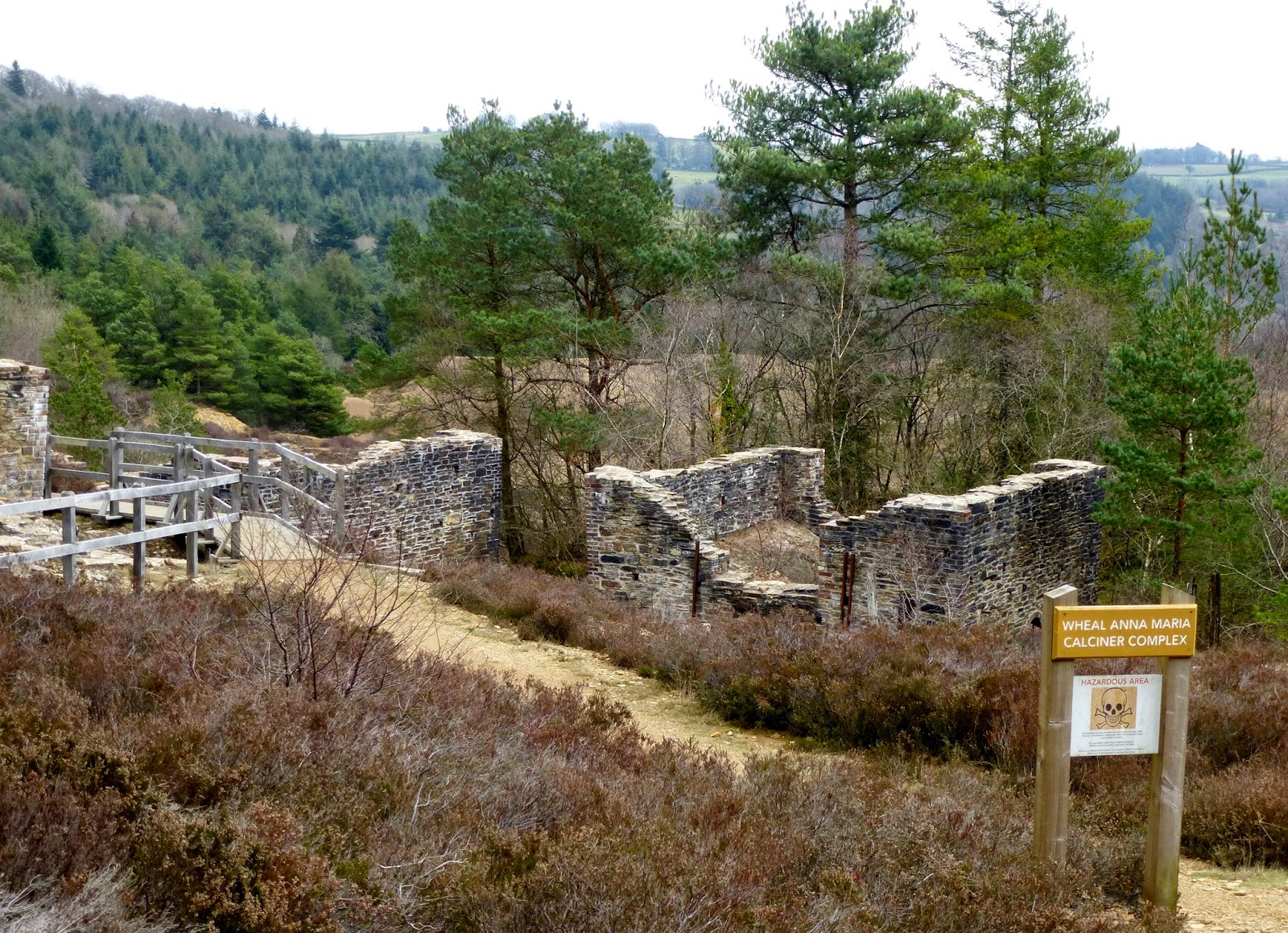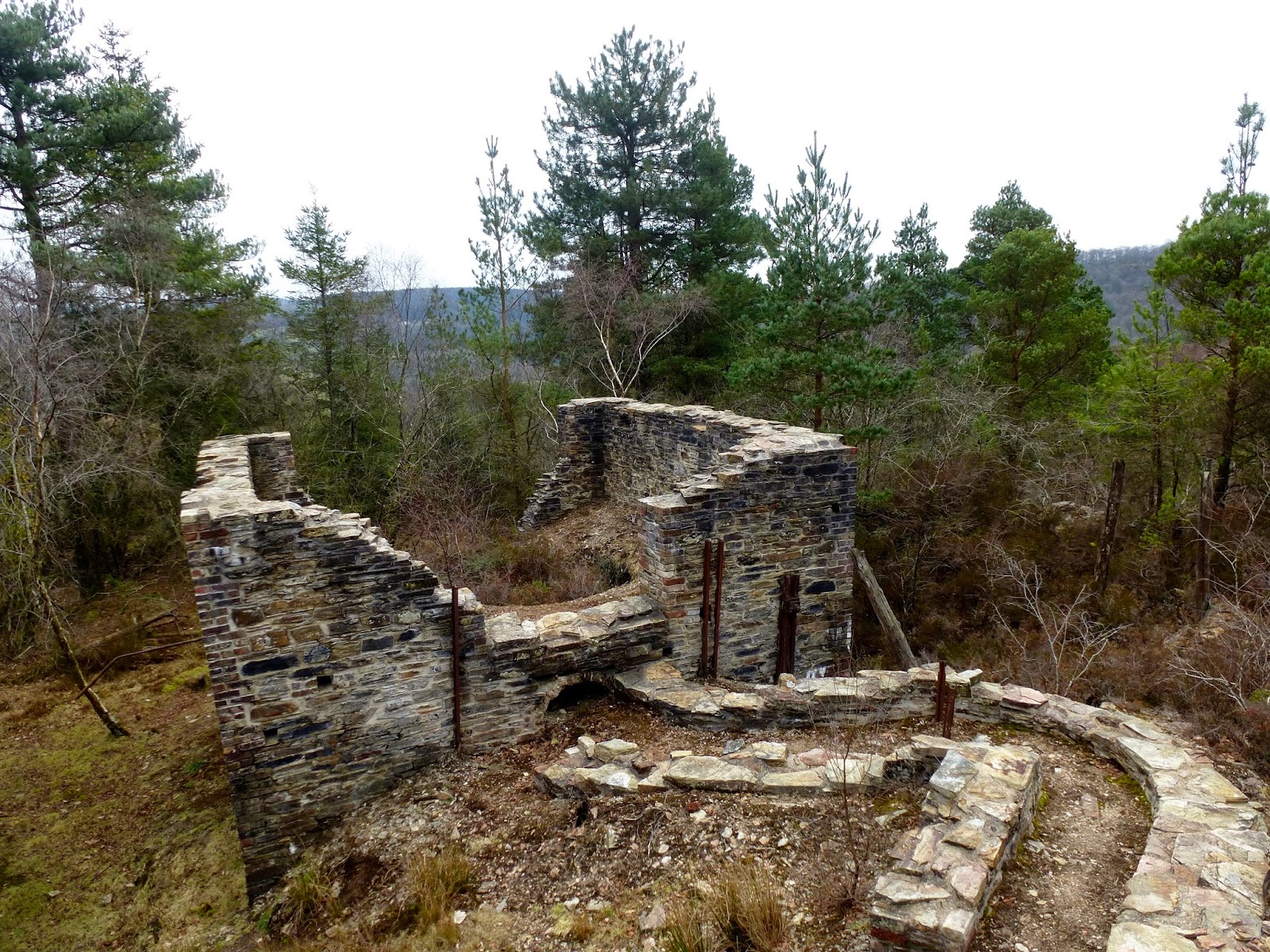Returning to nature
Last week we were given a guided tour around a nature reserve on Portland ....
 |
| Rosy garlic and white valerian |
 |
| Birds foot trefoil, hop trefoil and cat's ear (the large yellow flower.) |
 |
| Viper Bugloss |
 |
| Common blue butterfly |
It was lovely to see all the wild flowers, especially when they were growing in a hostile environment, amongst the rocky landscape seen below.
This is King Barrow Quarry,a disused quarry on the Isle of Portland. This island is famous for it's limestone. The island is 6 km long by 2.7 km wide. The causeway permanently links it to the Dorset coastline at Weymouth. Once there was over 100 quarries on the island, six are still operating today. The stone has been used over the centuries in the construction or facing of many public buildings in London, including St Paul's Cathedral,Whitehall, the Cenotaph and Trafalgar Square. After the Second World War Portland stone was widely used in those towns and cities that had been badly damaged e.g. Plymouth, Bristol and Coventry. It was also used in all the Commonwealth grave stones.
Historically the stone would have been extracted using hand tools - see this old British Pathe film ,which shows the methods used. The pieces of rock that weren't required were left strewn over the landscape. Dorset Wildlife Trust have given nature a helping hand - invasive plants such as cotoneaster have been removed by hand and the wild flowers have been nurtured and encouraged to spread. On the site we also found bee and pyramid orchids and the remains of a fossil tree (the images of which were difficult to capture, we had several heavy downpours!)
The modern day mining next door to King Barrow looks so different. However the mining companies are now working with the Wildlife Trust to ensure that the best outcome is achieved when the mine is no longer operational.
The remains of another quarry on the other side of the reserve, had previously been used as a landfill tip, the metal poles allowing the escape of methane gas.
The landscape around Dartmoor in Devon, also shows remnants of past generations - from bronze age huts and circles to old mine workings. The area around Tavistock, in particular, was industrial with tin,copper,iron and arsenic being mined.
It was only after we had been visiting this area for a number of years, that we discovered my husband's ancestors had lived and worked here.With the help of national lottery funding, a wide range of walks and cycle paths have opened up. Last year we took one of these walks through the woods and ended up at the great console, which was a series of mines.
There was a huge mountain of arsenic waste, which was all fenced off, a look out area with signs warning everyone to keep to the paths. To my surprise, on one of the noticeboards I discovered a picture of William Morris, who was well-known for setting up the Arts and Craft movement and who was against industrialisation. His family had owned one of the mines here and he had been given some shares and for a period of time sat on the board of the mine.
This part of his life seemed such a contrast to the beautiful flowers and patterns he created. I was intrigued by this, and carried out more research once I had returned home. He has always been a bit of a hero of mine, with his philosophy of a simple life and his words of "only have what you believe to be beautiful or useful in your home " have been a manta of mine for many years. It seems that the wallpapers he created used arsenic to create the green colours, This resulted in some people contracting arsenic poisoning with fatal results..
When the mines finally shut down here, the land was planted with pine trees to help prevent soil erosion and it is now a haven of wildlife.
Do you have any past industrial landscapes on your doorstep that have returned to nature ? I would love to hear about them.
Sarah x









The Rosy garlic is so pretty. Your first flower photos remind me of school days when our Botany teacher used to take my class into Derbyshire for the day looking at, and collecting the wild flowers in our tins (very non pc) on the peaks and in the dales - sadly schools dont seem to have botany lessons like that anymore - I think that it instilled a love of flowers.
ReplyDeleteReally interesting to learn about Wm Morris, his work is a love of mine too. Concerning the arsenic, so little was known then about the dangers to many workers handling such products. Last week I read about the young women who painted the illuminations on clocks with Radium, and who suffered all kinds of terrible illnesses and even death.
The best example I can think of concerning past industrial landscapes near us are the disused gravel-extraction beds near the M4 from Reading, going Eastwards, which are now very popular water-sports venues.
ReplyDeleteWhat a thought provoking post Sarah, particularly about the arsenic in William Morris wallpaper. Sometimes it's not always good to delve to deeply in the past of legendary figures, clearly they are not all they seem. I have happy memories of Portland, although it always seemed to be blowing a hooley whenever we went over. Portland bill was great for blowing the cobwebs away. There used to be a fabulous restaurant at a hotel over there. It was in a mock castle but I can't remember it's name. Lovely butterfly photo :) . Have a good week. B x
ReplyDeleteWas the restaurant at Pennsylvania Castle it was a hotel in the 1990's. Portland is a bit like Marmite you either love it or hate it. I used to think it was a bleak and windy place, but now I love it! Sarah x
DeleteYes that's the place. We had a wonderful evening there in 1974!
DeleteSo interesting and a very nice place to visit, the pictures are wonderful. I was thinking and indeed we have something like that on our doorstep.
ReplyDeleteI used to walk with my dog in our neighbourhood along the river, on dikes but also a hilly landscape with ponds, meadows and woods, a nature reserve for birds.
When I walked there and enjoyed the beauty of nature, I normally did not realize that these hills were formed first by debris of the bombing of Rotterdam during the 2nd World War and then served as a garbage dump of the city.
I always admired the beauty of your dog walks, it is hard to believe it was once a garbage dump! Sarah x
DeleteWhat a wonderful spot, it's always so good to see nature reclaiming land, although it would be better if it hadn't been spoilt in the first place. There are a few old gravel pits around here, now flooded and great for wildlife. CJ xx
ReplyDeleteI enjoyed my visit to Portland through your photographs Sarah - Lovely blog post :)
ReplyDeleteSuch an interesting post, and I didn't know about the mines there either and WM connection. I think old quarries make for rather special environments, attracting species favouring those conditions, in this case limestone - it is great that it is now managed as a nature reserve.
ReplyDeleteIn our area there's not that much landscape left. It's hard for people to imagine I guess but it's just impossible to walk or drive somewhere here in Flanders and not see a house when you look around. Politics want a betonstop by 2050 which means every new built has to be compensated with as much area given back to nature. They should not wait until 2050 to do that in my opinion but even then I have no idea how they will be able to do this. There's not much space left to build anyway. That said I think the first pictures of the lovely wildflowers are amazing. Letting nature taking over once industrialized areas is great but it's such a pity the original landscape was once destroyed. Where we live there's no original landscape left due to the first world war when literally everything was destroyed and had to be rebuilt or replanted. A scarred landscape forever.
ReplyDeleteYour post certainly got me thinking Sarah.
Have a lovely new week,
Marian
It does seem a long time to wait until 2050, there will certainly be much less land available then. You have taught me over the years, how the legacy of the first world war has had such a huge effect even today on your local landscape. Sarah x
DeleteA lovely look at your area with very interesting bits of history. Love the wildflowers!
ReplyDeleteIt is charming to see how nature can make an industrial landscape look so good, and to me, this is why: nature and humanity, in all its imperfections, is such a beautiful marriage. We learn to live together, to adapt. But OH how gorgeous these plants are, Sarah! ENJOY another pleasant day of nature's gifts!
ReplyDeleteLovely photos from your Portland walk, Sarah and interesting to learn about the hidden side of William Morris.
ReplyDeleteI used to live in Horrabridge and Dartmoor was my dog-walking area, so I have seen many of the abandoned mines and chimneys. Now I live in Cornwall, on the edge of Bodmin Moor, so once again I walk among the old mines and chimneys and see many areas where Nature has all but covered the abandoned granite stones and remains of buildings. I love the atmosphere as well as the beauty of the Moor, in all weathers, but prefer not to stray too far from civilisation when cloud suddenly descends and reduces visibility. My village, high on the Moor, is often covered in cloud and only when taking the descending road out of the village do I realise that there is sunshine and views elsewhere!
I too love the atmosphere around those abandoned buildings on Dartmoor and on the border of Devon and Cornwall. Sarah x
DeleteSuch an interesting post. It must have been great to discover part of your husband's heritage related to the place, ad if you were drawn there.
ReplyDeleteWe lived in Buchans, Newfoundland, a mining town, where the mine closed in the early 1980s. Tailings from the mine blew around town, leaving a fine dust over everything. The site was cleaned up in the recent past. I always thought of how we were breathing that stuff in and we didn't know what it contained. Industry is a double edged sword.
That is interesting to see and read about where the Portland stone comes from. I'm glad the local Wildlife Trust is involved here so nature can thrive. That is interesting about the connection with William Morris. I love the William Morris fabrics and prints I have at home, but what a terrible thing that the arsenic in the originals would have killed householders.
ReplyDeletelovely photos, my uncle worked in one of those quarries and I spent every summer visiting my grandparents in Portland so thank you for reminding me of so many happy times.
ReplyDeleteWhat a lovely way to find out about your roots, or rather, your husband's.
ReplyDeleteSarah, this was very interesting. I know of two reclaimed quarries: Winterthur in Delaware (USA) and Butchart Gardens on Vancouver Island (Canada).
ReplyDeleteHi Sarah, what an interesting post. It sounds like a great guided tour. I had no idea about the other life of William Morris, I've always been a fan of him too.
ReplyDeleteI used to manage the woodlands that surround Bennachie in Aberdeenshire. It is a range of hills with several quarries, some quite high up. The quarrying dates from the 1700s, mostly granite, and the whole area has such a historic feel (there's an Iron Age Fort too) as well as being very beautiful. I haven't been back for ages.....thinking about it now I want to take the kids there! Juliex
It would be nice to take the children there and notice the changes over the years too. Sarah x
DeleteWhat a lovely post.
ReplyDeleteAll the photos are wonderful, but that butterfly shot is fabulous.
Thank you for introducing me to your Portland, Sarah. It has an interesting history and certainly reflects how human beings have learned to cope with the effects of their living on earth! Locally, I am not aware of similar sites here in our Portland, Oregon, area, but will now be on the lookout for them. I was fascinated to visit Butchart Gardens in British Colombia, Canada and I admired how the limestone quarry there had been developed into such beautiful garden space. Have you visited there? xx
ReplyDeleteThose gardens do look amazing, I would love to visit there! Sarah x
DeleteSounds like an interesting tour. Those wildflowers look beautiful! Have a good week Sarah!
ReplyDeleteMadelief x
A fascinating post Sarah. I feel as if I was on that tour with you. Thank you.
ReplyDeleteHi Sarah, you always visit such fascinating places, thanks for sharing! William Morris is also a bit of a hero of mine too, he was such a defender of handcrafted beautiful things, a real inspiration, which continues to this day. Have a great week, we are thoroughly washed out here in Southsea... Sharon x
ReplyDeleteThe mountains we hike on are in a reserve called Silvermine. But the actual mining was trivial. So no rehab needed.
ReplyDeleteThere are much bigger issues around rehabilitating the mine dumps from gold in Johannesburg. Or sadly asbestos mines in the Northern Cape - where the miners are still battling for compensation.
So interesting about the mines and William Morris! The wildflowers are gorgeous! This is the best time of year!
ReplyDeleteVery interesting, Sarah! You always visit such wonderful places.
ReplyDeleteSigrun
What an amazing place to be able to explore. So many incredible plants. Near to where we live there are lots of old gravel pits which have been turned over to nature and there is a lot of incredible wildlife, including in one place a very important nightingale habitat. It is incredible that nature can take these places back and make them beautiful again isn't it.
ReplyDeleteI would love to visit the quarry so full of limestone loving flowers. Good to know that the Wildlife Trust are looking after it. The rosy garlic looks stunning, like a pink starburst.
ReplyDeleteI remember being quite disillusioned to hear about William Morris and the arsenic wallpaper!
A very nice post and interesting too.
ReplyDeleteIt's wonderful how nature does reclaim the land.
All the best Jan
Very interesting Sarah, I knew that limestone from this area had been used in St Paul's Cathedral, but not much more. It is very positive to have the Wildlife Trust working with the mining group at King Barrow, I must check if this is happening in Australia, so much mining going on here all the time...always hard to be a balance.
ReplyDeleteHello Sarah,
ReplyDeleteA very interesting post indeed! The wildflowers are just beautiful. Thank you so much for sharing the history
blessings
Penny
Fascinating stuff. I love all the wild flowers x
ReplyDeleteGreat place to visit with interesting history. Those flowers are amazing!
ReplyDeleteHow strange that your husband's family came from Dorset - there must have been a pull for you. It's good to see how nature takes back its own, given the opportunity. I love your butterfly!
ReplyDeleteThanks for the post and the beautiful photos, Sarah. Portland can feel a bit desolate but that’s why I like it. Is there any news about the proposed Eden Project-2? I have to admit to having mixed feelings about it as it will make the area busier than it already is.
ReplyDeleteAs for post-industrial landscapes, here in Devon we have many remnants of former industry on Dartmoor and by most water inlets in south Devon there is a disused lime kiln dating from the early 19th century.
Jurrassica are meant to be applying for planning permission before the end of the year, and have a pop up event at the end of August. Sarah x
Delete